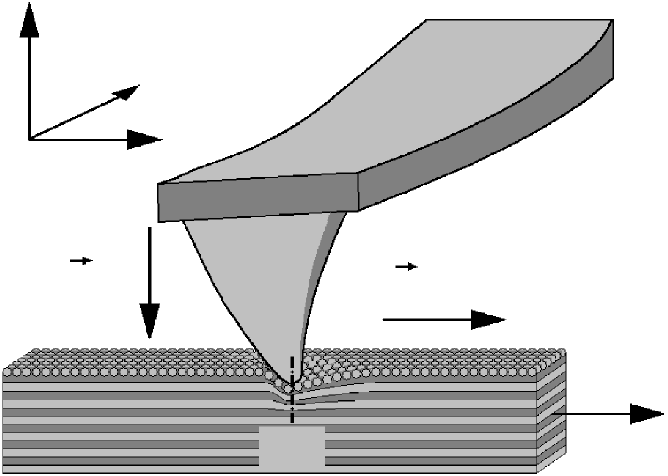Friction Force Microscopy (FFM): Probing Nanoscale Friction and Adhesion
What is Friction Force Microscopy?
Friction Force Microscopy (FFM) is a powerful scanning probe microscopy technique used to investigate nanoscale friction, adhesion, and wear properties of surfaces. It is a variant of Atomic Force Microscopy (AFM) that specifically measures the lateral forces acting on the AFM probe as it scans across a sample surface. FFM provides valuable insights into the tribological behavior of materials at the nanoscale, which is crucial for understanding and controlling friction in various applications, from microelectromechanical systems (MEMS) to advanced lubricants.

Working Principle of FFM
FFM operates on the same basic principle as AFM, using a sharp probe attached to a flexible cantilever to scan the sample surface. However, in FFM, the focus is on measuring the lateral deflection of the cantilever, which arises from the friction forces between the probe tip and the sample. The key components of an FFM setup include:
- AFM Probe: A sharp tip, typically made of silicon or silicon nitride, is mounted on a flexible cantilever. The probe tip interacts with the sample surface during scanning.
- Laser and Photodetector: A laser beam is focused on the back of the cantilever, and the reflected beam is detected by a position-sensitive photodetector (PSPD). The lateral deflection of the cantilever due to friction forces causes a change in the laser spot position on the PSPD.
- Feedback Loop: A feedback loop is used to maintain a constant normal force between the probe and the sample during scanning. This is achieved by adjusting the height of the sample or the probe using a piezoelectric scanner.
As the probe scans across the sample surface, the lateral deflection of the cantilever is recorded, providing a map of the friction forces. The magnitude of the friction force is proportional to the lateral deflection of the cantilever, which can be calibrated using known reference samples.
Modes of Operation
FFM can be operated in two main modes:
Contact Mode FFM
In contact mode FFM, the probe tip is in constant contact with the sample surface during scanning. The lateral deflection of the cantilever is directly related to the friction force experienced by the probe. Contact mode FFM is suitable for studying relatively hard and non-deformable surfaces, as the constant contact can cause damage to soft or delicate samples.
Dynamic Mode FFM
Dynamic mode FFM, also known as tapping mode or intermittent contact mode, involves oscillating the cantilever near its resonance frequency. The probe tip intermittently taps the sample surface, reducing the lateral forces and minimizing potential damage to the sample. In dynamic mode FFM, the change in the oscillation amplitude or phase due to friction forces is measured, providing information about the nanoscale friction properties.
Applications of FFM
FFM has a wide range of applications in various fields, including:
Tribology
FFM is extensively used in tribology, the study of friction, wear, and lubrication. It enables the investigation of nanoscale friction mechanisms, such as stick-slip motion, and the evaluation of lubricants and coatings at the molecular level. FFM helps in understanding the fundamental origins of friction and developing strategies to control and minimize it.
Material Science
FFM is a valuable tool for characterizing the surface properties of materials, such as polymers, composites, and thin films. It can provide insights into the nanoscale variations in friction, adhesion, and mechanical properties, which are crucial for designing and optimizing materials for specific applications.
Nanotechnology
In nanotechnology, FFM is employed to study the tribological behavior of nanostructures, such as nanoparticles, nanowires, and 2D materials like graphene. Understanding the friction and wear properties at the nanoscale is essential for developing reliable and durable nanodevices and nanoelectromechanical systems (NEMS).
Challenges and Future Perspectives
Despite the significant advancements in FFM, several challenges remain. One of the main challenges is the quantitative interpretation of FFM data, as the measured friction forces depend on various factors, such as the probe geometry, surface roughness, and environmental conditions. Developing standardized calibration methods and reliable models for interpreting FFM data is an ongoing research effort.
Future research in FFM will focus on improving the spatial resolution, sensitivity, and speed of the technique. The development of novel probe designs, such as functionalized tips and multi-probe arrays, will enable the investigation of nanoscale friction in more complex systems, such as biological samples and heterogeneous materials. The integration of FFM with other characterization techniques, such as Raman spectroscopy and scanning electron microscopy, will provide a more comprehensive understanding of the nanoscale tribological properties.
Further Reading
Materials Today, Friction force microscopy
